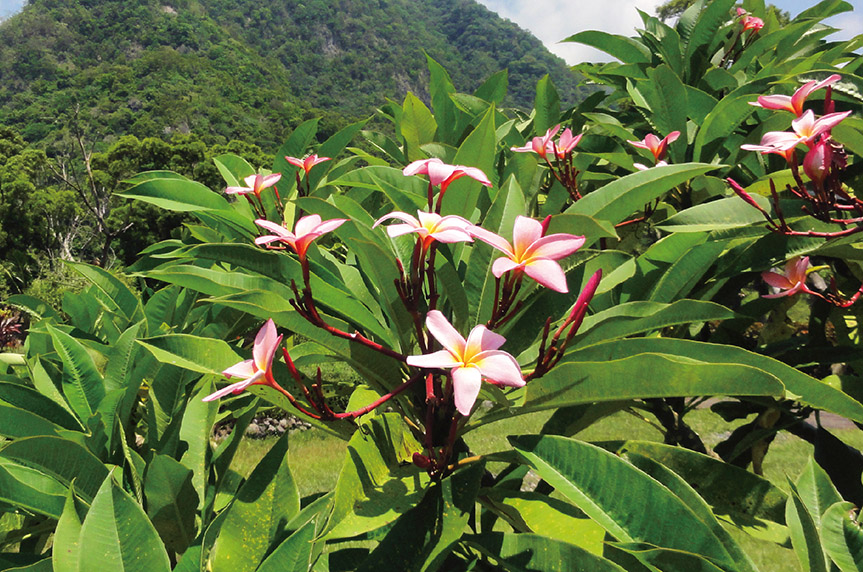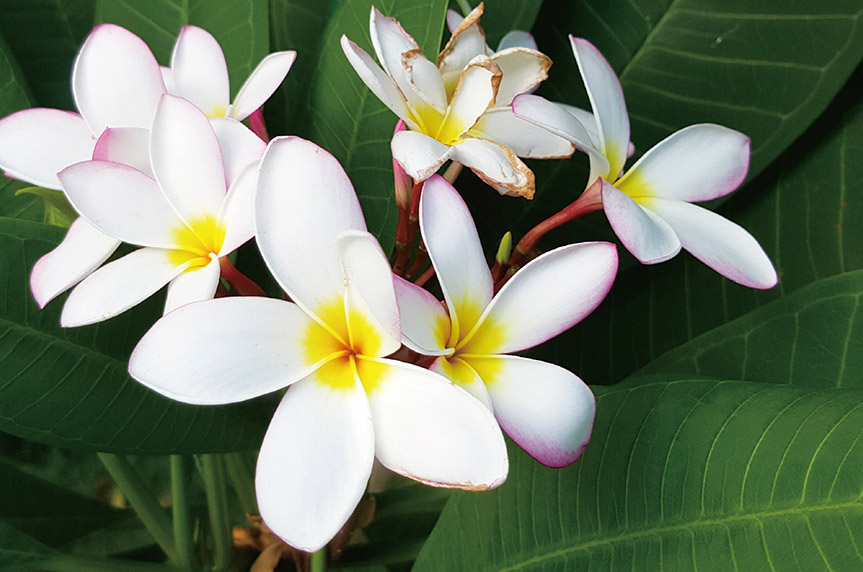
落葉性小喬木,株高3~5公尺,樹皮灰白,枝條粗肥軟柔狀,受傷泌有白色乳汁。單葉互生,簇生枝頂,柄長2~5公分,葉片長20~30公分,寬5~10公分,闊披針形或長橢圓形,葉基楔形漸銳尖,葉尖漸銳尖,全緣,側脈平行25~35對。頂生聚繖花序,兩性花;具花梗總軸,長8~15公分;花萼細小5裂;花瓣(冠)漏斗形,長5~6公分,5裂,橢圓形,覆瓦狀排列,外部乳白色或紅色,中心及基部為黃色或黃,具芳香;雄蕊5枚,著生於冠筒基部,極為細小;子房半下位。花期5~7月,果實為蓇葖果,相對雙生條柱形,長約15~25公分,熟後側裂;種子多數,褐色,扁凹狀。落葉後可看到明顯留於枝上之「葉痕」,受傷會分泌白色乳汁。

原產中南美洲之墨西哥、巴拿馬至南美之委內瑞拉一帶。臺灣最早於荷據時期(西元1645年)引進栽種,於郁永河「裨海紀遊」(西元1697年)中『…番花,葉似枇杷,花開五瓣,白色,木本,臃腫,枝必三叉。花心漸作深黃色,攀折累三日不殘。香如梔子,病其過烈,風度花香,始覺濃郁。自四月至十月開不絕,冬寒併葉俱盡。』應即指此種。另於日據時期又陸續引進;品種有紅花緬梔、雜交緬梔等,此類花色粉紅或濃紅,花瓣尖長,迴旋覆瓦狀排列較不明顯。因其原種花瓣乳白似蛋白,而中心基部具有鮮明的黃色又如蛋黃,故名雞蛋花;此外,緬梔在2、3月間落葉時,光禿禿的粗肥綠色樹枝極像鹿角,因此別稱「鹿角樹」。

夏威夷原住民喜歡將緬梔串成花環,當作節慶活動時的妝飾,又衣著、飾品、建築物等亦處處可見緬梔花圖騰;加勒比海的婦女則取其鮮花為頭髮或衣物的薰香材料。而在寮國則將之定為國花;比鄰的泰國、緬甸、柬埔寨也都普遍可見栽植。中國雲南西雙版納的傣族村寨,則被寺院定為必須種植的「五樹六花」之一,是該區佛教寺院中(上座部佛教)不可或缺的植物,甚有「廟樹」(Temple Tree)之稱。

緬梔常見栽種於一般公園及校園;又落花常以旋轉方式直線墜落,舖散地面或水面呈現一片繽紛落英,因此常被星級飯店栽種作為私秘空間內之園景,及芳香療法的香料植物,更是廣東民間傳統五花茶(材料:金銀花、菊花、雞蛋花、葛花、木棉花等,可發揮清熱解毒、利濕散風、消炎功效)的材料之一,亦可提煉香精供製高級化妝品和香皂等化工產品。
緬梔葉的提取物可以用來治療肺結核、瘧疾、卵寄生蟲、炎症、感染、皮膚病、性病等疾病;另鮮花浸膏可做食品香精、食品添加劑,並有延緩衰老化和抗氧化作用。推測荷蘭人引進此樹除了花朵美麗外,也與當時生存環境不佳,蛥蚘魍魎(讀音:舌回網兩)之境,本種具有瘧疾療效有關。莢竹桃科的植物多數具有毒性,本種亦然。直接生食將造成嘔吐、腹瀉、發燒、惡心、嘴唇紅腫、心跳加速等現象,應請注意。
Mexican frangipani is a deciduous tree that typically grows to around 3–5 meters tall. Its tree bark is light gray, soft, and produces white sap. Its leaves are alternate, 20–30 cm in length, 5–10 cm in width, long oval shaped, and acute at the tip. Its yellowish white flowers grow in panicles, and blossom during May to July.
This plant is native to Mexico and Central America. It was introduced in Taiwan in 1646 by the Dutch and was further planted by the Japanese during their occupation. Mexican frangipani is generally regarded as an ornamental tree, and can be seen planted in parks and schools. The native Hawaiians are known to use its flowers to craft headbands for celebrations and ornaments. The flower is also a national flower for Laos. In Yunnan, China, this tree is regarded as one of the five sacred trees, and is present in every local temple. In Guangdong, China, its flower is one of the ingredients for the five flower tea. However, most of the plants that belong to the Apocynaceae family, including Mexican frangipani, are poisonous. Consuming raw parts of the tree, including the flowers and fruits, will cause serious health risks.
